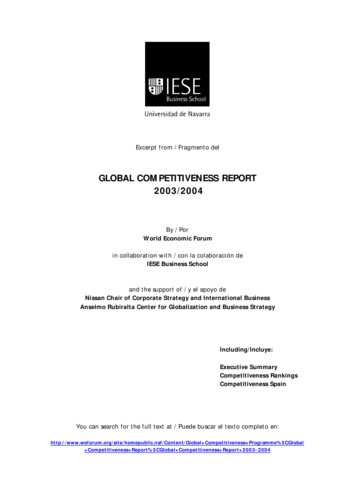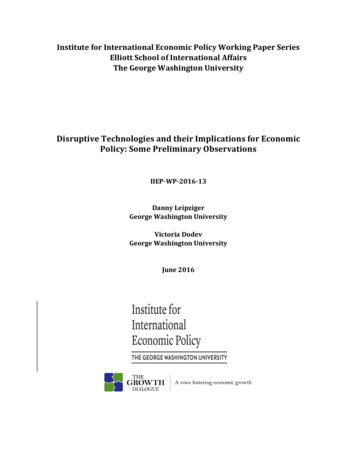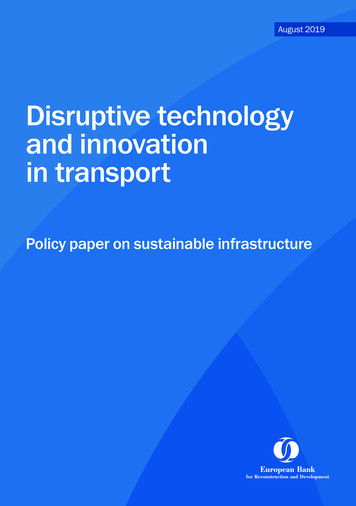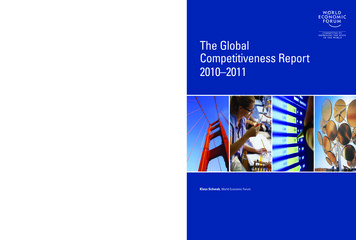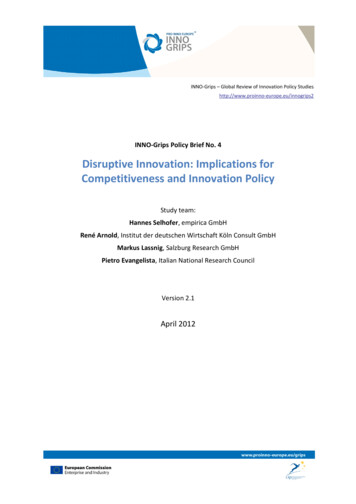
Transcription
INNO-Grips – Global Review of Innovation Policy -Grips Policy Brief No. 4Disruptive Innovation: Implications forCompetitiveness and Innovation PolicyStudy team:Hannes Selhofer, empirica GmbHRené Arnold, Institut der deutschen Wirtschaft Köln Consult GmbHMarkus Lassnig, Salzburg Research GmbHPietro Evangelista, Italian National Research CouncilVersion 2.1April 2012
Policy Brief: Disruptive innovationAbout this document and INNO--GripsThis policy brief was prepared by empirica GmbH, Bonn, with the support of the Institut derdeutschenen Wirtschaft Köln Consult GmbH, Salzburg Research GmbH and the Institute for ServiceIndustry Research (IRAT) at the Italian National Research Council (CNR), in the framework of INNOINNOGrips innogrips2),), the “Global Review of Innovation Policy Studies”,on behalf of the European Commission, DG Enterprise and Industry. INNO-GripsINNO Grips supports policypolicymakers in adopting appropriate responses to emerging innovation needs, trends and phenomena. Itis part of the European Commission's PRO INNO EuropeEurportal (http://www.proinnohttp://www.proinno-europe.eu), afocal point for innovation policy analysis and cooperation. The INNO-GripsINNO Grips policy analysis andmonitoring (Lot 2) is carried out by empirica GmbH and ICEG European CenterCent er with support from theInstitut der deutschenn Wirtschaft Köln Consult GmbH,GmbH, based on a service contract with DG Enterpriseand Industry.AcknowledgementsThe INNO-Grips study team would like to thank the experts who supported the reseresearch work for thispolicy brief by sharing their sectoral and/or innovation expertise with the study team, by reviewingthe draft document and by providing comments and suggestions at the INNO-GripsINNO Grips workshop on thethsame issue in Brussels on 24 January 2012.DisclaimerNeitherher the European Commission nor any person acting on behalf of the Commission is responsiblefor the use which might be made of the following information. The views expressed in this report arethose of the authors and do not necessarily reflect those of thet he European Commission. Nothing inthis report implies or expresses a warranty of any kind.ContactFor further information about this policy brief or INNO-Grips,INNOplease contact:empirica Gesellschaft für KommunikationsKommunikationsund Technologieforschung mbHOxfordstr. 253111 Bonnhttp://www.empirica.comEuropean CommissionDirectorate-GeneralGeneral Enterprise and IndustryD.1 - Policy development for /dg/Rights restrictionsMaterial from this policy briefrief can be freely used or reprinted but not for commercial purposes, and,if quoted, the exact source must be clearly acknowledged. Recommended quotaquotation: "EuropeanCommission (2012): Disruptive Innovation: Implications for Competitiveness and Innovation Policy.INNO-GripsGrips Policy Brief No. 4, prepared by empirica GmbH for DG Enterprise and Industry, as part ofthe INNO-Grips project.Bonn/Brussels, April 20122
Policy Brief: Disruptive innovationTable of contents1Executive summary . 52Context, objectives and approach. 133452.1Context and objectives. 132.2Methodological approach. 16The concept of “disruptive innovation”. 173.1Disruptive innovation in the OECD innovation framework . 183.2Analysing disruptive innovation in a Porter framework . 203.3Christensen’s disruptive technology framework. 223.4Critique and debate of Christensen’s work . 26Sector case studies . 324.1Disruptive innovation in the chemical industry. 324.2Disruptive innovation in the automotive industry . 454.3Disruptive innovation in tourism. 524.4Disruptive innovation in transport and logistics . 65Strategic responses for innovation policy . 725.1General conclusion. 725.2Specific issues and recommendations. 73Annex I: Sector definitions and additional information. 77Annex II: References . 81Annex II: Study team. 863
Policy Brief: Disruptive innovation4
Policy Brief: Disruptive innovation1Executive summaryAs such, any type of innovation (product,process, marketing or organisational innovations) can be disruptive – in practice, theconcept refers mainly to product and processinnovations. The manual warns that it may notbe apparent from the start whether an innovation has a disruptive impact until long after ithas been introduced – a major challenge foranalysing disruptive innovation if not conducted with hindsight (see Section 3.1).1.1 Context and objectivesThis policy brief was prepared as part of theINNO-Grips project which supports policymakers in adopting appropriate policy responses to emerging innovation needs, trends andphenomena.The brief discusses the concept of disruptiveinnovation in the sense introduced byChristensen’s seminal work ‘The Innovator’sDilemma’ (1997). Christensen’s framework hasbeen widely discussed in management literature, but not yet in terms of its implications forinnovation policy design. This brief addressesthis gap. It explores whether and how innovation policy should pay specific attention todisruptive innovation trends and, if so, howthis could be achieved. The brief applies theframework to analyse potentially disruptivetrends in four industries, including manufacturing and service sectors:Christensen’s disruptive technology frameworkThe term disruptive innovation is widely usedtoday in the sense introduced originally asdisruptive technology in Christensen’s seminalwork ‘The Innovator’s Dilemma’ (1997).Christensen links his observations with thewidely used S-curve of a technology life-cycleand the concept of value networks. He arguesthat a truly disruptive technology cannot beplotted in a conventional framework, becausethe new technology (at least initially) competeson criteria incommensurable with those thatwere typically used to measure performance.- the chemical industry (Section 4.1)- the automotive industry (Section 4.2)- tourism (Section 4.3)Product performance- transport & logistics (Section 4.4)The brief is based on a review of the literatureregarding disruptive innovation, interviewswith industry experts and the results of a validation workshop (on 24th January 2012 in Brussels) where interim results were presented anddiscussed with a group of innovation experts.Performance asdefined inApplication “A”technology 2technology 11.2 The theory of disruptive innovationPerformance asdefined inApplication “B”technology 2Time or engineering effortThus, the disruptive technology operates in theearly phase of its life-cycle in a different valuenetwork. For example, it is often used indifferent applications (see right part of Figure).Often, the innovative technology is initially lesscomplex and offered at a lower price, appealing to low-end, price-sensitive customer segments. After some time, however, when thetechnology has matured, it may surpass theincumbent technology even in terms of thetraditional performance criteria that used toDisruptive innovation in the OECD innovationframeworkThe OECD’s Oslo Manual (2005), a widely usedframework for measuring innovation activities,defines disruptive innovation as “an innovationthat has a significant impact on a market andon the economic activity of firms in thatmarket. This concept focuses on the impact ofinnovations as opposed to their novelty.”5
Policy Brief: Disruptive innovationrule the market and will gradually proceed toreplace it (see left part of Figure). The point atwhich disruptive innovations start to challengeexisting products is when the marginal utilityof further improvements in the traditionalperformance criteria decreases.technology framework is suitable for making exante predictions.Business-model vs. product innovations:Markides (2006) suggests that a distinctionshould be made between disruptive businessmodel innovations and product innovations, asthey are completely different in their impacton established firms. He also argues that thedisruptive and the traditional model can coexist in some markets.The incumbents, including large companies,may fail to understand the early signals thatindicate a technological shift as they are toofocused on the current demand pattern oftheir leading customers. They place all theirinnovation efforts in continuously improvingthe performance in terms of the traditionalcriteria, to the extent that they ‘overachieve’.In the shadow of this race to be top dog, thedisruptive technology starts to gain a footholdin other markets or areas of implementation(‘value networks’), often delivered by newentrants (see Section 3.3).Implications for business strategy: there is acontroversial discussion about the rightbusiness strategy to address disruptiveinnovation, for instance whether first-moversare always those to benefit most, and howincumbents should deal with potentiallydisruptive technologies.1.3 Disruptive innovationchemical industryDiscussion of Christensen’s workChristensen’s work on the impacts ofdisruptive technology and how companiesshould deal with it has triggered an intensediscussion and critique of the concept inacademic and business literature. The mainaspects that have been controversiallyaddressed in papers include the following (seeSection 3.4):intheAs a provider of innovative materials andtechnological solutions, the chemical industryplays an important role in industrial innovationand competitiveness as a whole. It is a highlymature industry with stable product categories, players and value systems. Nonetheless,R&D and innovation are very important; newprocesses and materials requiring chemicalproblem-solving expertise play a key role inaddressing global challenges such as climatechange (see Section 4.1).Lack of a precise definition: a cornerstone ofthe debate is the lack of a measurabledefinition how exactly disruptive innovationdiffers from other (non-disruptive) innovations,and how to select adequate performancemetrics to plot the performance provided bythe disruptive technology.The impact of chemical innovations in otherindustriesThe chemical industry is a catalyst for enablingsmart and sustainable growth. There arenumerous examples of innovations –includingdisruptive ones– in other industries which aremainly or at least partly enabled by innovationsin the chemical industry. For example, newpolycarbonates are an important base foroptical storage media and liquid crystals fordisplays. Today, innovations originating in thechemical industry are needed more than everso that everybody can have clean air, safewater, healthy food, reliable medicine, andenvironmentally friendly products and so thatHigh-end vs. low-end disruptive innovations:several authors suggest to make a distinctionbetween high-end and low-end disruptiveinnovations. Low-end disruptions start theirlife-cycle in lower-cost segments of the market,appealing to price-sensitive consumers. Highend disruptions are typically more radical intheir novelty and compete with existingproducts or services not on cost, but byoffering distinctive features.The predictability of disruptive innovations: akey question is whether the disruptive6
Policy Brief: Disruptive innovationmaterials and energy production can becomemore sustainable.New materials developed by the chemicalindustry play a key role, for instance, in allrelevant fields of energy (e.g. catalysts transforming biomass into bio fuel, use of fibrereinforced polymeric materials to improve theperformance of wind turbines, chemicalmaterials in photo voltaic systems).Key innovation areas with a significant disruptive potentialThe following areas of innovation were foundto be particularly relevant in terms of theirdisruptive impact on the chemical industry andothersectors:processintensification,innovation in feed stock use, in advancedmaterials, and the field of nanotechnology.Policy implicationsThe central objective for policy responses todisruptive innovation trends is uncontested:Europe must take a pro-active approach tomaintain its role as an innovation leader, inparticular in cutting-edge domains which mayhave disruptive impacts in different areas ofthe economy. Innovation has already beenidentified as a key success factor specifically forthe competitiveness of the chemical industryby a High Level Group (HLG) on the Competitiveness of the European Chemicals Industry.Process intensification: the chemical industry,as well as other process industries, are aboutto undergo a fundamental change in theirproduction processes. Process intensification(PI) has been discussed for many years, but hasnow gained momentum as new break-throughtechnologies emerge. Novel process approaches constitute a disruptive shift in processdesign which can lead to massive sizereductions of equipment or plants. This hasimportant implications for the raw materialefficiency of processes and for achievingreductions in greenhouse gas emissions. TheSPIRE proposal (“Sustainable Process Industrythrough Resource and Energy Efficiency”), anindustry proposal for a public-private partnership for research and innovation, gatheringpartners from different industries, is a goodexample for mechanisms to support innovationin this field.The following issues arise from the discussedtechnological shifts in the chemical industryand their importance for addressing globalchallenges such as climate change:- A systemic approach: building platforms forlarge scale, cross-sector cooperation andinnovation activities in Europe, whichreflectthethatmanydisruptivetechnologies require expertise fromdifferent industries.- Solving the business case: the costs forswitching to more energy-efficient technologies (capital write-offs) must be sharedin a fair way.Alternative feedstocks: the high prices ofpetroleum and natural gas, the uncertaintyabout remaining reserves, and the pressure toachieve a lighter carbon-footprint have led toconsiderable efforts in the chemicals industryto widen its feedstock base, particularlythrough broader use of bio-based renewableraw materials as replacement and complementfor fossil feedstocks. In principle, a largeamount of chemical substances could beproduced from renewable raw materials, butthe technical and logistical difficulties must notbe underestimated.- Regulation and the cultural context:Europe needs to find the right balance between safety regulations and accepting risksby fostering innovation in new technologies.- Encourage research on substitutes for rareearth elements and other scarce materials.Advanced materials: innovative chemicalmaterials are an indispensible requirement fortechnological progress in many sectors andequally important as innovation in processesthat address global environmental challenges.7
Policy Brief: Disruptive innovation1.4 Disruptive innovationautomotive industryinthethe magnetic raw materials needed for themost common type of electric engines, it iswell positioned to compete in this market.The main innovation trends in the automotiveindustry are determined and driven by globalmegatrends, in particular the shortage of rawmaterials (notably, but not only, oil) andclimate change. These create challenges for theautomotive industry on a technological butalso on a supply-chain level (see Section 4.2).Potential shifts in the mobility paradigmThe current mobility paradigm, in which thecentral value revolves around car ownership, isalso not favourable for electric cars (as long asthey are expensive). Some analysts thereforequestion the disruptive nature and success ofthe concept as a whole.Rising oil prices and increasing environmentalawareness of consumers as drivers of changeIn Europe and the USA, consumer awareness ofclimate change and pollution is growing. Fueleconomy is probably the most pressingchallenge for car-makers, irrespective of thetype and size of the car. To tackle thischallenge, car-makers have several options,ranging from reducing the weight of their carsto switching them completely from internalcombustion engines (ICE) to electric engines.On the other hand, there are also two majorsocietal trends that could benefit the fasterdeployment of electric cars: (i) the trendtowards urbanisation, and (ii) changing valuesand lifestyles, with regards to mobility, amongthe young generation, as cars seem to partlylose their function as a status symbol. If thesetrends develop further, they could have adisruptive impact on the way we are framingmobility (from ownership to access, e.g.through car-sharing).Electric vehicles – uncertainty about theirdisruptive impactPolicy implicationsIt is still unclear to what extent electric cars willfinally be successful (and disruptive), orwhether they will remain a niche market. In ascenario where mobility concepts change(“mobility as a service”), BEVs offer clear-cutadvantages and would very likely createopportunities for completely new businessmodels. In this framework, there are someimplications for innovation policy:Replacing an ICE by an electric engine hasnumerous technical implications, ranging fromthe remainder of the drive-train to issues ofcrash safety, as well as maintenance.Moreover, the necessary charging infrastructure requires significant changes in thepower grid which shall influence the economyfar beyond the automotive industry. As such,from a technological perspective, the move toelectric cars has a disruptive impact.1. Electrical vehicles help to overcome the oildependency of cars; however, as variousmaterials needed to produce the engines aregenerally rare and expensive, and mostlylocated within China, it would basically meanswitching from one dependency to another.Innovation policy should therefore strengthenresearch on electrical engines into a directionthat leads to as little dependency as possible(e.g. supporting R&D in magnet-free electricalengines).However, from a consumer’s point of view, abattery electric vehicle (BEV) is not disruptiveas long as the objective is to develop BEVs tothe same specifications in terms of range andspeed as current ICE-cars. So far, BEVs areessentially unattractive to the majority ofconsumers due to their shortcomings inconventional performance criteria, includingprice and range.Developments in China could play a critical rolein this context. China heavily subsidises thepurchase of electric cars and plans to have500,000 electric cars, buses and lorries on itsroads by 2015. As China owns above 90% of2. Considering current trends in major economies, especially in China, promoting thedevelopment of electrical vehicles is to beadvised, in spite of the uncertainty. The risk of8
Policy Brief: Disruptive innovationbacking the wrong horse has to be weighedagainst the risk of losing competitiveness in theemerging technology.for the chosen package. DP can have disintermediation as well as re-intermediationeffects, yet it is not expected to fully substitutepre-packaged deals and should rather beconsidered an incremental innovation.3. If innovation policy decides to support BEVs,the best approach is therefore probably toencourage the move to ‘mobility as a service’.This could have positive side-effects such asreducing emissions and freeing up parkingspace in cities.(3) Yield management systemsYield (or revenue) management systems areintegrated information systems which contribute to the revenue optimisation of supplycapacities by (semi-)automatically and dynamically regulating prices and quantities. Althoughit is a significant marketing or even businessmodel innovation, it will rather not have adisruptive impact.1.5 Disruptive innovation in tourismThe importance of innovation was long underestimated in service industries, includingtourism. The major turning point came withthe rise of the internet in the 1990s and itssignificant (and even disruptive) impacts. Infact, tourism is probably one of the sectors inwhich the internet has had one of its mostsignificant impacts, as it leads to disintermediation in some markets, re-intermediationin others and increases dramatically themarket transparency.(4) Internet customer feed-back portalsIn this policy brief, five major innovationtrends in the sector are discussed in terms oftheir impact (see Section 4.3)Online reviews of other travellers have notonly become an important source for takingdecisions about which accommodation orrestaurant to choose, the reviews eveninfluence the decision on travel destinations.They have a strong impact as they furtherincrease market transparency. However, thereis no evidence that this impact is going tochange products, services, business models orvalue networks in the tourism industry.(1) Booking on the internet(5) Low-cost airlinesClose to 40% of all bookings (e.g. for hotels andflight tickets) in Western Europe and in theUSA are made on the internet. This development has transformed parts of the valuenetwork in tourism. It poses a threat toestablished service providers, such as conventional travel agencies, and has been anopportunity for new entrants such as onlinebooking sites. Internet booking therefore has astrong disruptive potential. Europe, in particular its accommodation sector, could benefitfrom the trend towards online bookings.In recent decades, the most important changein the airline industry has been the trendtowardsprivatisationandenhancedcompetition – most prominently resulting inthe emergence of the no-frills, low-costcarriers (LCC). Their emergence has stronglyreduced average fares in European air traveland posed a significant threat to theincumbents and was clearly disruptive.Policy implicationsThe strategic response of economic andinnovation policy should consist in creatingpositive framework conditions for Europeantourism companies to adopt these innovationsin the best possible way. The goal must be tomaximise the net benefits (accepting that thedisruptive trends will not benefit all), byensuring that the European tourism industry isa leader in innovation, regarding to the dis-(2) Dynamic packagingDynamic packaging (DP) combines offeringsfrom more than one data source on demandand according to customer preferences. Usingpre-determined packaging rules, which are setand controlled by the service provider, andhiding price transparency on the individualcomponents, a combined price is determined9
Policy Brief: Disruptive innovationcussed trends, compared to its competitors.However, these policies are broadly in line withexisting schemes to support innovation. Thereis no evidence that would call for a ‘reactive’response in the form of a specific disruptiveinnovation policy design for the tourism sector.1.6 Disruptive innovationtransport industryinis the formation of new types of alliancesbetween third-party logistics providers (3PLs)and companies operating in other servicesectors such as financial services, managementconsulting and ICT vendors. Some of thesealliances have given rise to the creation of anew category of service provider called fourthparty logistics provider (4PL). This can be seenas a disruptive trend in service provision andbusiness models, as the 4PL model enablescustomers to outsource to a single organisationthe entire re-engineering of their supply chainprocesses.theICT as a key driver of (disruptive) innovationInformation and communication technology(ICT) is a key enabler of innovation in thetransport and logistics service industry.Investment in ICT by logistics providers isusually triggered by specific requests fromcustomers, who are aware that increasedperformance of their logistics providers willbenefit the logistics performance of the entiresupply chain.Policy implicationsPolicy actions to remove innovation barriersshould concentrate on supporting and accelerating the use of ICT in transport and logistics.Means to address this goal include:- Stimulate higher ICT expenditure throughfiscal actions;While large multinational logistics groups havemassively invested in ICT to support theiroperations for a long time and gained substantial benefits, SMEs have more difficulties insetting up ICT applications and the potential oftechnology is largely underestimated.- Reassess education and training systems atall levels in this sector;- Better coordinate initiatives for disseminating technology solutions for transportand logistics systems.Main innovation trendsThere are three main innovation trends whichare triggered and enabled by ICT (see Section4.4)New e-services: the integration of traditionalservices with new, innovative informationservices facilitated by the internet. Theseenhanced services do not have a significantdisruptive potential, however.New players: ICT has facilitated the marketentry of a new intermediary: different types oftransportation e-marketplaces. They may havea disruptive impact on several aspects of theindustry; for instance, they tend to alter therole of traditional transport intermediaries(e.g. freight forwarders) and the relationshipsbetween these firms and other actors in thesupply chain.New alliances: Another innovation resultingfrom the diffusion of ICT and web technologies10
Policy Brief: Disruptive innovation1.7 Strategic responses for policyindustries. Strengthening cross-boundary innovation processes may require innovativemechanisms, e.g. establishing technology platforms involving stakeholders from differentindustries.It is widely uncontested that Europe must takea pro-active approach to maintain its role asan innovation leader, in particular in cuttingedge domains which may have disruptiveimpacts in different areas of the economy. Thekey question for this policy brief was whetherinnovation trends which are expected to havea disruptive impact in the economy alsorequire a special ‘disruptive innovation policy’.Should policy ‘react’ to disruptive trends?2. Dealing with ‘business case conflicts’A major challenge for innovation policy arises ifthe desired and ex-pected externalities fromaccelerating disruptive innovation deploymentdo not coincide with the industry’s businesscase (at least in the short and medium term):how should the cost for shortening the S-curvebe shared?The authors of this policy brief do neither seeclear evidence for the need nor an opportunityfor a specific ‘disruptive innovation policy’intervention. In particular, given the long termnature of disruptive technology development(which typically takes 10-20 years from theirinvention to their widespread deployment inproducts), this policy brief does notrecommend any short-term interventionsspecifically in response to any of the describeddevelopments.3. Anticipating unwanted side-effects of interventionsSubsidies and grants are a policy instrumentfrequently used to accelerate the adoption ofnew technologies, for instance in the area ofrenewable energies (e.g. subsidies forphotovoltaic power generation). However, thisis not without risk – policy is well advised toconduct an impact assessment of possible sideeffects and of the longer-term impacts beforelaunching such measures.Rather, the strategic response of economic andinnovation policy should consist in creatingpositive framework conditions for innovation inEurope (irrespectively of whether innovationswill be incremental or disruptive in theirimpact), with the objective to strengthen thegeneral capabilities for innovation.4. Understanding disruptive innovation inservice sectorsThe case studies on tourism and transportshow that ‘disruptive innovation’ can have atotally different meaning in services than inmanufacturing.Inservices,disruptiveinnovation is typically linked to new businessmodels that have been made possible byinnovative uses of technologies provided byother sectors, notably ICT, rather thanconducting R&D. The implications forinnovation policy are therefore quite different.However, even if the brief does not see abusiness case for a specific framework fordisruptive innovation policy, some policyrelevant issues arise from the sector casestudies which should be considered whendiscussing disruptive technologies. While theyare generally relevant for innovation policy (aswell as for economic policy), they areparticularly important the more ‘disruptive’ anew technology is likely to be. These issuesare:1. The cross-sectoral nature of disruptiveinnovationsA com
Christensen's seminal work 'The Innovator's Dilemma' (1997). Christensen's framework has been widely discussed in management litera-ture, but not yet in terms of its implications for innovation policy design. This brief addresses this gap. It explores whether and how inno-vation policy should pay specific attention to

